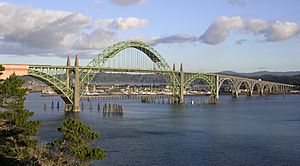Yaquina Bay Bridge facts for kids
Quick facts for kids Yaquina Bay Bridge |
|
|---|---|
 |
|
| Carries | |
| Crosses | Yaquina Bay |
| Locale | Newport, Oregon |
| Maintained by | ODOT |
| Characteristics | |
| Total length | 3,223 ft (982 m) |
| Longest span | 600 ft (183 m) |
| Clearance below | 133 ft (40.5 m) |
| History | |
| Opened | September 6, 1936 |
|
Yaquina Bay Bridge No. 01820
|
|
| Location | OR Coast 9, US101, MP141.67, Newport, Oregon |
| Area | 4.4 acres (1.8 ha) |
| Built | 1936 |
| Architect | Conde B. McCullough, et al. |
| MPS | McCullough, C.B., Major Oregon Coast Highway Bridges MPS |
| NRHP reference No. | 05000821 |
| Added to NRHP | August 5, 2005 |
The Yaquina Bay Bridge is a beautiful arch bridge that stretches across Yaquina Bay in Newport, Oregon. It's one of the most famous bridges along U.S. Route 101. A talented engineer named Conde McCullough designed it. This bridge was one of eleven major bridges he designed for the Oregon Coast Highway. It replaced the last ferry crossing on the highway, making travel much easier.
Building the Bridge
Work on the Yaquina Bay Bridge started on August 1, 1934. It opened to traffic just over two years later, on September 6, 1936. The bridge cost about $1.3 million to build back then. That would be like spending over $28 million today!
A lot of people worked hard to build this bridge. About 220 workers helped pour 30,000 cubic yards (23,000 m³) of concrete. They also put together 3,100 tons of steel. The main arch was built from both sides, meeting in the middle. Strong supports called "tiebacks" held the arch pieces in place until they connected. The bridge's piers, which are its main supports, go deep into the ground. They rest on timber poles driven about 70 feet (21 meters) below sea level. The project received money from the Public Works Administration, a government program that created jobs during the Great Depression.
Bridge Design and Features
The main part of the bridge is a 600-foot (183 m) long arch. The road goes right through the middle of this arch. On each side of the main arch, there are two smaller 350-foot (107 m) steel arches. Then, five concrete arches, getting smaller in size, extend to the south side.
The bridge has special decorative touches. Tall, tower-like concrete shapes mark the main piers. Smaller decorations are at the ends of the side arches. The arches are built like strong, hollow boxes. The road on the bridge is 27 feet (8.2 m) wide and has two lanes for cars. There are also two sidewalks, each 3.5 feet (1.1 m) wide, for people to walk on. The highest point of the main arch is 246 feet (75 m) above sea level. The entire bridge is about 3,260 feet (994 m) long. This includes the concrete sections that lead up to the main bridge. Ships can pass under the bridge through a channel that is 400 feet (122 m) wide and 133 feet (41 m) high.
The bridge's design uses styles from the Art Deco and Art Moderne periods. These styles were popular in the 1920s and 1930s. You can also see some ideas from Gothic architecture. For example, the railings have small pointed arches, like those found in old cathedrals. At each end of the bridge, there are special areas for people to stop and enjoy the view. These plazas have stairs that lead down to nearby parks. There were plans to add sculptures of seals to the bridge, but they were never built.
A Special Landmark
The Yaquina Bay Bridge is a very important structure. It was added to the National Register of Historic Places on August 5, 2005. This means it is recognized as a significant historical place in the United States.
Gallery









